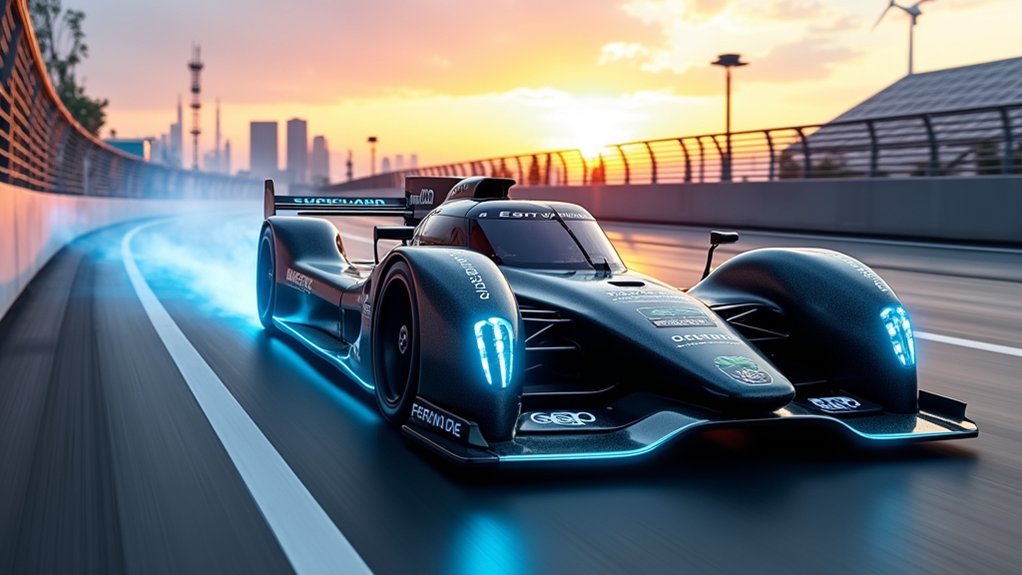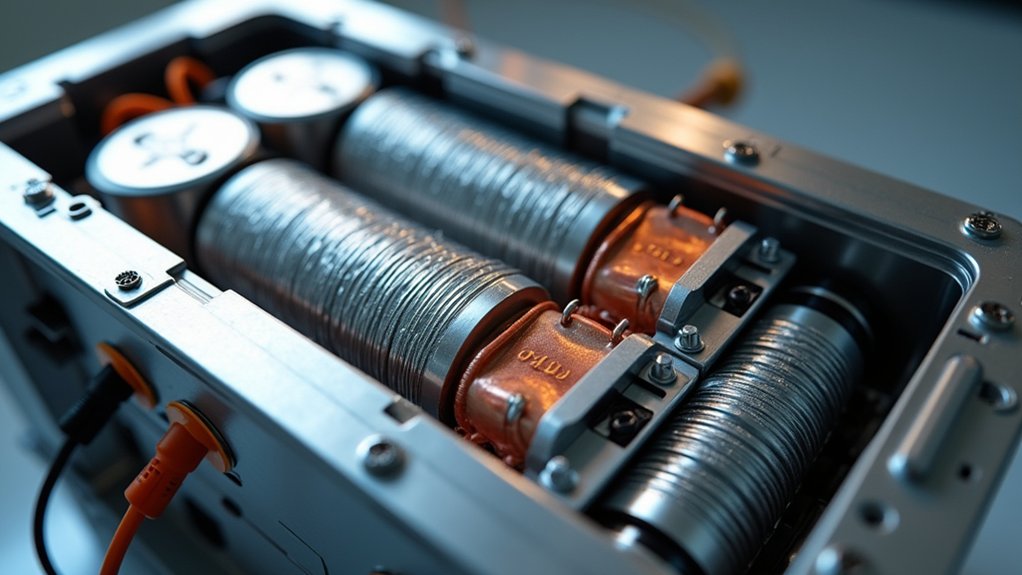Formula E has revolutionized motorsport since its 2014 debut, pioneering all-electric racing with cutting-edge technology and sustainable innovation. The championship’s GEN3 cars now achieve 350 kW power outputs and speeds up to 322 km/h, while featuring regenerative braking systems that recover energy at 600 kW. Racing through iconic global cities, Formula E serves as an essential testbed for electric vehicle advancement, consistently pushing performance boundaries while promoting environmental responsibility. The evolution of this revolutionary series continues to accelerate.

Since its groundbreaking debut in Beijing in 2014, Formula E has redefined the boundaries of motorsport by introducing the world’s first all-electric single-seater racing championship. The brainchild of Alejandro Agag and Jean Todt, this innovative series emerged as a platform to promote sustainable mobility and combat urban air pollution while pushing the boundaries of electric vehicle technology.
The technical evolution of Formula E cars has been remarkable, with power outputs increasing from 200 kW in GEN1 vehicles to an impressive 350 kW in current GEN3 machines. These cutting-edge racers now achieve speeds of up to 322 km/h, demonstrating a 75% increase in power over their predecessors. The implementation of regenerative braking systems, capable of recovering energy at up to 600 kW, showcases the series’ commitment to efficiency and innovation. The cars can accelerate from 0 to 100 km/h in just 2.8 seconds. The series has become a hotbed for innovation in electric vehicle technology, attracting major manufacturers worldwide.
Formula E’s technological leap from GEN1 to GEN3 vehicles showcases remarkable progress in electric racing, with speeds and power reaching unprecedented levels.
The championship’s structure features 11 teams and 22 drivers representing prestigious manufacturers like Maserati, Porsche, and Jaguar. Racing takes place on challenging street circuits in major global cities, with unique elements like Attack Mode adding strategic depth to the competition. The series consistently delivers more overtaking maneuvers than Formula 1, creating an engaging spectacle for fans worldwide. The eco-friendly practices implemented in Formula E are setting new standards for sustainable motorsport.
Formula E’s impact extends far beyond the racetrack, serving as a vital testbed for innovations that benefit consumer electric vehicles. Advancements in energy management, drivetrain efficiency, and aerodynamics developed through racing directly contribute to the ongoing global EV revolution. The series’ commitment to sustainability is evident in its pursuit of net-zero carbon emissions and partnerships with renewable energy providers.
The championship has successfully established itself as a global entertainment brand, hosting races in iconic cities such as Rome, New York, Berlin, and Seoul. This strategic approach of bringing racing to urban centers has effectively raised awareness about sustainable mobility while demonstrating that high-performance motorsport can coexist with environmental responsibility.
The series continues to evolve, pushing technological boundaries while maintaining its core mission of promoting clean energy solutions through exciting competition.
Frequently Asked Questions
How Much Does a Formula E Race Car Cost?
A Formula E race car costs approximately €890,000, as regulated by FIA’s 2024 spending cap.
The major components include a €200,000 battery system, €250,000-350,000 powertrain, and €299,600 Spark-supplied chassis.
Additional expenses comprise Michelin tires at €3,200 per set, €20,000 brake systems, and various spare parts.
Operational costs throughout the season considerably increase the total investment.
What Happens if a Formula E Car Runs Out of Battery Mid-Race?
When a Formula E car’s battery depletes mid-race, the vehicle experiences progressive power loss before complete shutdown.
Drivers must retire immediately, as FIA regulations prohibit unpowered vehicles on track for safety reasons. The team faces significant championship point penalties, while advanced monitoring systems typically alert drivers well before critical depletion.
Battery exhaustion can result in up to a 10% performance loss per degree over maximum temperature limits.
Can Formula E Drivers Switch Between Gas and Electric Racing?
While drivers can technically switch between racing disciplines, the change requires significant adaptation.
Formula E’s unique energy management systems, regenerative braking protocols, and specialized powertrain controls differ substantially from traditional motorsport.
No current Formula E driver simultaneously competes in gasoline series, though former F1 drivers like Lucas di Grassi have successfully adapted by mastering electric-specific techniques.
Different tire compounds and thermal efficiency characteristics further complicate crossover attempts.
How Loud Are Formula E Cars Compared to Formula 1?
Formula E cars produce approximately 80 decibels, while Formula 1 cars generate considerably louder noise levels of around 134 decibels.
The stark difference stems from their distinct powertrains – Formula E’s electric motors create a characteristic whirring sound from motor operation and tire friction, whereas F1’s combustion engines produce intense mechanical roars.
This 54-decibel gap means F1 requires ear protection for spectators, while Formula E enables conversation-friendly urban racing.
Do Formula E Races Take Place on the Same Tracks as F1?
Formula E and F1 largely operate on different circuits, with Formula E primarily utilizing street circuits in urban centers while F1 races on dedicated tracks.
Only a few venues overlap between the series, particularly Monaco and Mexico City’s Hermanos Rodríguez Circuit, where Formula E uses modified layouts.
When sharing venues, Formula E typically adapts the circuit configuration to accommodate electric vehicles’ unique characteristics, often bypassing long straights and incorporating tighter turns.










2 comments